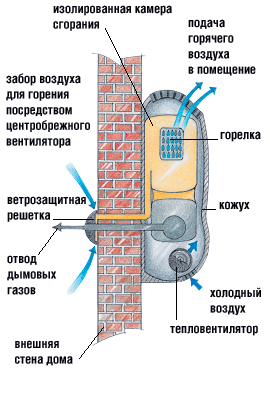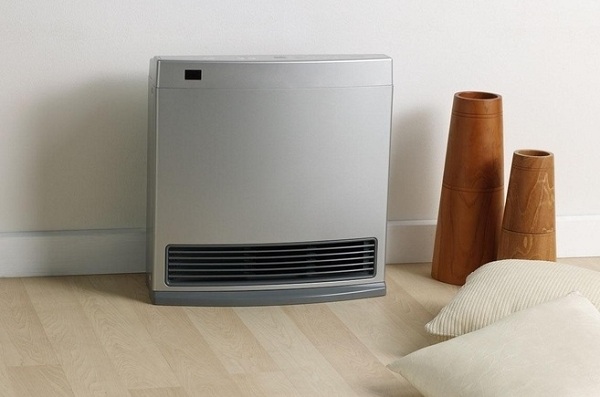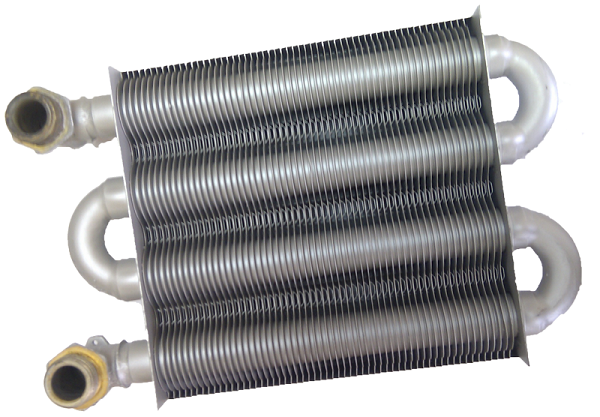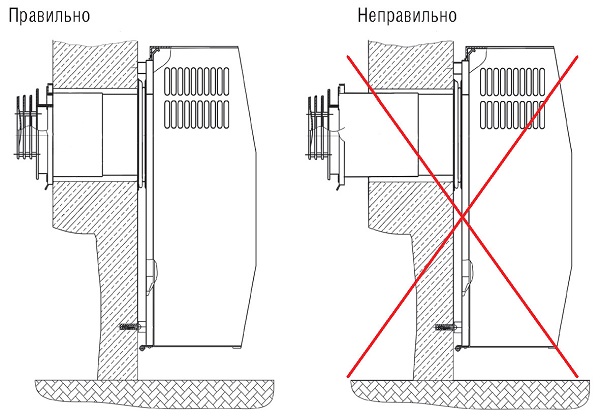What is a gas convector heating
There are a huge number of devices for heating on the market of heating equipment: heat guns, infrared heaters, radiators, oil radiators and different types convectors. But consumers know little about what a gas convector is.
Content
Device heater and principle of operation
Gas heat convector is an apparatus that is able to generate heat due to gas combustion. The design of the unit is quite simple.
- Burner. It is connected to the igniter.
- A heat exchanger whose task is to release heat to the air passing through it.To heat more air, the heat exchanger is made ribbed (to increase the area).
- System for removal of combustion products.
- The automation system is installed for safety reasons and turns off the unit in case of problems in operation.
- Thermostat, maintains the desired temperature in the room.
- The case serves to protect the device and is made of metal coated with heat-resistant paint.
The figure below shows the gas convector device.

The principle of operation of the device is that the gas, when burned in the chamber, heats heat exchanger. The air flow, passing through the lower holes of the unit, moves through the heat exchanger, takes heat and leaves heated to the room through the upper holes. In the meantime, gas combustion products are expelled from the chamber using double wall pipe (coaxial). Through it, fresh air enters the apparatus from the street to support the burning process.

Principle of operation of the convector
Types of gas convectors
Heaters are classified by type of installation - models are wall and floor. Distinctive features wall mounted devices can be called their compactness, low weight, efficiency. But they are limited in performance. Their maximum power ratings can reach only up to 10 kW. If you want to warm up a room with a large area, then for this it is better to use a model. outdoor type But such heaters have a large mass, due to the large size of the heat exchanger. Their power can reach several mW.

Wall mounted gas boiler
Advantages and disadvantages of gas convectors
Among the advantages of gas heaters are the following factors.
- Economic indicator. Electricity convectorsMuch cheaper than gas heating systems. But the latter win in the low cost of operation. For example, if you take a standard model with a cast iron heat exchanger with a capacity of about 3 kW, then its cost will be 2 times higher compared to an electric one of the same capacity. We also know that 1 kW of electricity and 1 m3 gas prices are similar. But to produce 1 kW of heat energy, only 0.1 m is required.3 gas. Due to this, savings are achieved during operation.These calculations are applicable only when using gas convectors on the main natural gas.
- The possibility of using bottled gas. The unit is easily converted to work on propane. This feature allows you to use gas convectors for gardening or other places where there is no main gas supply. But in terms of economic indicators, devices for heating on bottled propane are also not profitable, as are electric ones.
- Environmental friendliness. The heater with a closed combustion chamber does not burn oxygen in the room.
- The heat carrier is not required. To use this type of gas heaters, installation of a water heating system is not required, as is the case with independent heating (gas boiler). This is convenient if you use the unit in the country or in the garage. In winter, when the device is turned off, the water in the system will not freeze, as there is no liquid in it.
But there are such devices and certain disadvantages of use.
- Insufficient compactness. The higher the power of the heating unit, the larger its size, especially if it is a floor option.

- Poor heating of the room, if the room has many doors or windows. In this case, you have to put the heater under each window, which is not justified from a financial point of view. If you install one heater, the air in the corners of the room will remain cold.
- Rapid cooling of the heat exchanger. This disadvantage applies only to cheap models with a steel heat exchanger.
Convector selection
How to choose a gas convector? First of all, attention is drawn to the technical characteristics of the unit. The best option can be considered a device with a closed combustion chamber and a heat exchanger made of cast iron. Important is the presence of a programmable control unit. Consider other factors that should be paid attention to when choosing a domestic gas convector.
Machine power
Since heating occurs due to air circulation, the units work effectively in only one room. Therefore, for each room will require the installation of a separate unit. Power is determined by the calculation: 1 m2 square required 100 watts.
Heat exchanger material
Since gas convectors of heating work on gas that burns in a special chamber, the heat exchanger is exposed to strong temperature effects.If it burns through after some time, the device fails. Therefore, the material of this part must be resistant to high temperatures. The leader among the materials for the heat exchanger is cast iron. This metal is resistant to thermal loads, besides it cools down very slowly and evenly distributes heat. Gas convectors with a cast iron heat exchanger can last up to 50 years. The main disadvantages of such devices are the high price and large mass of the unit. Heater with heat exchanger become cheaper and has less weight. But when choosing a unit, you should pay attention to the quality of steel. Steel heat exchangers can last no less than 20 years.

Type of combustion chamber
Heaters may differ structurally by the type of combustion chambers:
- Open the combustion chamber. Installation of the unit with such a camera requires the installation of a chimney with access to the roof. In addition, during operation of the unit, to maintain the combustion process, air will be drawn from the room. Therefore, good room ventilation is required.
- Closed the combustion chamber. Such models are more popular because they do not require the output of the pipe through the roof (a coaxial pipe is installed opposite the apparatus).And another advantage can be called the fact that oxygen is not burned in the room, since the air intake occurs outside the building.

Fan
A gas convector with a fan quickly and evenly warms the entire room. Due to the forced air supply to the heat exchanger, the latter is better cooled. And since overheating is not allowed, the life of the heat exchanger is significantly increased.
Type of room
If you want to install a convector in the apartmentthe best choice would be an apparatus having a closed-type combustion chamber and a chimney with a coaxial pipe. This type of apparatus does not burn oxygen in the room. AT private buildings you can install any type of heaters. But when using a device with an open combustion chamber, the room must have fresh air ventilation.
Type of fuel
The use of liquefied gas is prohibited in apartment buildings. Therefore, the device is connected only to highway. In private homes use gas convector on bottled gas it is possible, provided that the cylinder is installed on the street in a special metal cabinet.

Amount of fuel consumed
Fuel consumption in gas equipment for heating is considered economical. The following basic parameters are accepted for the calculation of gas consumption:
- per 1 kW of power required 0.11 m3 gas from the pipeline;
- per kW of power will require 0.09 m3 liquefied gas.
Based on these indicators, you can make a calculation. For example, a 4 kW heater (designed for 40 m2 area) will spend 0.44 m3 gas per hour, and per day - 10.56 m3. But, since the device does not work constantly, this figure will be much less.
Similarly, you can calculate the flow rate for a gas convector on liquefied gas.
Convector installation
Before installing a gas convector, it is necessary to study the requirements and recommendations for installation, which are described in the instructions for the device.
- How to install such a heater in a wooden house? Indeed, in the process of operation, the housing can heat up to 55 ° C. In this case, it is necessary to isolate the wooden surfaces from the parts of the unit. When using a coaxial pipe, its insulation, when passing through a wooden wall, is not required.
- Height above floor. When installing wall mounted gas convectors, it is recommended that they be mounted as close to the floor as possible.As a result, the circulation of air flows becomes more intense, and the efficiency of the device increases.

- Gas pipe it is necessary to bring the device only from the street, and the installation of a stopcock is required before the junction of the pipe with the unit.
Before installing a gas convector, you must choose a place to place it. According to GOST, the unit should be mounted under the window. The main installation steps are described below.
- We try on the device to the selected place, we transfer with the help of a tape measure the place for the holes for the chimney and the gas pipe. In some models, the gas pipe is supplied from the bottom, so you need to leave space for it.
- After that, the most time-consuming operation is to be performed - punching a large-diameter hole in the wall for the exhaust pipe. You can use a perforator and make a hole with a diamond crown. If there is no crown, then you can punch the wall by switching the hammer drill to the jackhammer mode (when the hammer drill works, a lot of dust will form, therefore, cover all the furniture with a film beforehand).
- Next, you need to prepare the holes for fasteners and hammer dowels in them.
- Now you can connect the pipe to the heater and the junction to process sealant (high-temperature).
- Lift the machine along with the pipe and insert it into the hole in the wall, then fix the device with screws. Since the unit is heavy enough, you will need help to lift it. Floor heater has special legs.
- After that, it is necessary to seal all the gaps between the chimney and the wall with high-temperature sealant or foam.
- At the end of the chimney, attach a cap that prevents the flame from blowing by the wind (the hood and fasteners to it come bundled with the appliance) - the installation of the gas convector is complete.

Connection to the main line, as well as repair of gas equipment, must be made only by specialists. If you intend to use a gas convector with connection from a cylinder, then special permission is not required. But it is still better for the gas service workers to do this.
In conclusion, it can be said that the use of gas convection equipment can be a relatively simple and inexpensive solution to the problem of heating for different types of premises.Attracts the fact that the installation of such equipment does not cause much difficulty (except for connecting the device to the highway).

/rating_off.png)












